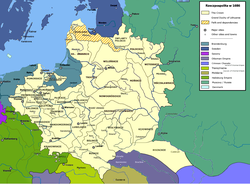Ottoman Ukraine
Ottoman Ukraine (Ukrainian: Османська Україна), Khan Ukraine (Ukrainian: Ханська Україна, Romanian: Ucraina Hanului), Hanshchyna (Ukrainian: Ганьщина)[1] is an historical term for right-bank Ukraine (as well as the southern regions of the Kiev Voivodeship) also known after its Turkic name Yedisan. The first mentioned records are traced to 1737 when the Russian secret agent Lupul was urging to attack the Ottoman Ukraine.

History
Officially, the territory had belonged to the Crimean Khanate since the 1520s. The territory appeared as a consequence of the 1667 Treaty of Andrusovo, which divided the Cossack Hetmanate, without consideration of the local population between the Polish Crown and Muscovy. Since 1669, the Ottoman authorities granted protectorate to the Cossack statehood west of the Dnieper and designated it into a separate sanjak which was headed by Cossack Hetman Petro Doroshenko. It was confirmed by the Treaty of Buchach in 1672.
The territory was bordered to its west by Podolia Eyalet and its south by Silistra Eyalet. With the help of Petro Doroshenko, the Ottomans were able to occupy Podolie and established its province in 1672. In 1676 the new King of Poland, Jan III Sobieski, managed to recover some if the lost territories of Ukraine and stopped paying a tribute after signing the Truce of Zhuravno. Also in 1676, Ivan Samoylovych, along with the Muscovy boyar Grigory Romodanovsky, led a successful campaign against Doroshenko forcing him to surrender and occupied the Cossack capital, Chyhyryn. Between 1677 and 1678 a powerful army of Ibrahim Pasha fought over the control of Chyhyryn (see Russo-Turkish War (1676–81)). Eventually, the army of the Grand Vizier Kara Mustafa Pasha was successful in taking control over Chyhyryn, in 1678. The city of Nemyriv became the Hetman residence between the 1670s and 1699.
After the 1681 Treaty of Bakhchisarai, Ottoman Ukraine came under the government of Moldavia by Hospodar George Ducas.
In 1685, the King of Poland revived some Cossack freedoms in right-bank Ukraine and signed the Eternal Peace Treaty of 1686, with Muscovy securing an alliance against the Ottoman Empire.
Sanjak-beys
- 1669–1676 Petro Doroshenko
- 1678–1681 Yuriy Khmelnytsky
- 1681–1684 George Ducas
- 1684–1685 Teodor Sulymenko
- 1685–1685 Yakym Samchenko
- 1685–1685 Yuriy Khmelnytsky
- 1685–1695 Stepan Lozynsky
- 1695–1698 Ivan Bahaty
- 1698–1699 Petro Ivanenko
Most of the Ottoman Ukraine became part of the independent Crimean Khanate (under protectorate of the Russian Empire) in 1774 except for the Ochakiv region which remained part of the Ottoman Empire.
References
- Petro Kraliuk. The Ukrainian Hanshchyna that preceded Novorossiya (Украинская Ганьщина, предшествовавшая Новороссии). Newspaper "Den". 5 December 2019
Sources
- Sapozhnikov, I. Zaporizhian Cossacks of the Ochakiv region and Ottoman Ukraine during the "Crimean protection" (1711–1734). History of Cossacks portal.
- Hrybovsky, V. Ottoman Ukraine. The Ukrainian Week. August 7, 2009